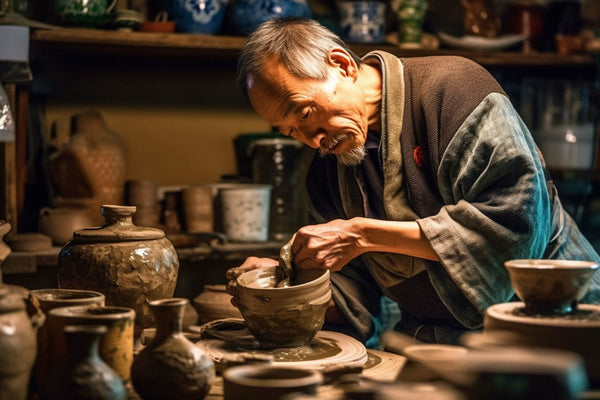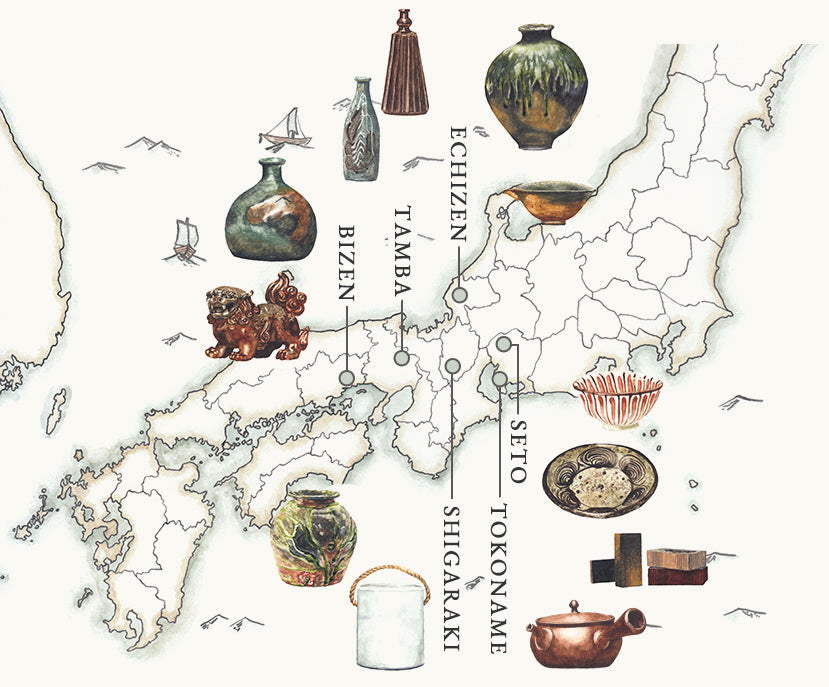
Oldest Japanese Pottery are Called Six Ancient Kilns
Do you know that there are six types of pottery with the oldest history in Japan? Let us introduce you to the pottery that has built up its culture over a long period of time in Japan, a country that boasts thousands of years of history.
what is Japanese six ancient kilns?

The six ancient kilns of Japan is the collective name for six types of pottery with the oldest history in Japan. All of these ceramics have a history of around 1,000 years, and all of them are still being produced today with techniques inherited from their predecessors. In 1948, the name was given by the antique ceramics researcher Fujio Koyama, and in 2017, it was recognized as a "Heritage of Japan". The relationship between Japanese people and pottery dates back to the Jomon period, when pottery was treated as a necessity for daily life, used to preserve food and as cooking utensils using fire. Pottery was also used in rituals, and it can be said that pottery was an indispensable item in building human and Japanese civilization.
The Japanese people have deepened their pottery culture throughout their long history. Among the ancient pottery kilns, six representative kilns with the oldest history were designated by Fujio Koyama as "Echizen, Seto, Tokoname, Shigaraki, Tanba, and Bizen," and they are collectively called the "six ancient kilns of Japan. Among the pottery produced in the six ancient kilns of Japan, each region uses different clay, raw materials, and techniques, and the pieces produced are different and appealing in their own way. This article explores the unique charm of each type of pottery.
Types of the six ancient kilns of Japan
The six ancient kilns of Japan are concentrated in central parts of Japan, such as Osaka and Aichi Prefectures.
Bizen Pottery (Bizen City, Okayama Prefecture)

Bizen Pottery is one of the oldest kilns in Japan and is especially famous for its large tea bowls and jars. Characterized by its rugged expression and stately design, it has developed its own unique pottery style. During the Muromachi period (1333-1573), Bizen ware was highly valued as tea ceremony utensils and loved by tea masters. Bizen ware is so hardy that it is said to be "unbreakable even when dropped," and is a vessel that inspires affection for its ultimate simplicity. It is used as teacups, sake cups, teapots, and vases. One of the characteristics of Bizen ware is that it has minute pores on its surface, which create fine bubbles. When beer is poured or tea is poured into a Bizen ware, it becomes mellow to the palate, making it even more delicious to drink. For more information, please visit Bizen Pottery article
Seto Ware (Seto City, Aichi Prefecture)

Seto Ceramic Ware is one of Japan's leading ceramics ceramic centers, with a history dating back to ancient times. It produces a wide variety of pieces and is characterized by its unique techniques and decorations. A wide variety of expressions can be seen in celadon, white porcelain, and underglaze blue. The unique style and rich design make them suitable not only as works of art but also for daily use. Even today, the term "Setomono" is widely used to refer to pottery in general, and is widely used as tableware such as tea bowls, teacups, and plates. It is the oldest pottery with a long history and is also one of the three major Japanese ceramics (the other two being Arita-yaki and Mino-yaki), making it one of the most representative pottery in Japan. For more information, please visit Seto Pottery article
Shigaraki ware (Koka, Shiga Prefecture)

Shigaraki ware is most famous for its "raccoon dog figurines. They are popular as lucky items that bring good luck and are said to have various benefits. Among them, it is particularly popular among people engaged in business, as it is said to enhance eight aspects of luck, called eight-phase lucky charms.
- Kasagi: protects you from calamity and evil.
- Eyes: With large eyes, they pay attention to their surroundings and make the right decisions.
- Smile: Always smiling leads to prosperous business.
- Virtue: to acquire human virtue.
- Passbook: to build a good relationship of trust with customers
- Big belly: to have calmness and boldness in decision making
- Money bag: for good luck with money
- Tail: All's well that ends well. Everything ends well.
Other Shigaraki ware has been highly praised for the skills of its craftsmen, and this Shigaraki ware has shown a wide range of activities, such as contributing to the provision of works of art at the World Exposition. This pottery can be recommended as a tea utensil, including raccoon dog figurines, teacups, and teapots. For more information, please visit Shigaraki Pottery article
Tokoname Ware (Tokoname City, Aichi Prefecture)

Tokonameyaki is famous for its kyusu, or teapot, as represented by the Shudo kyusu. In the Chita Peninsula, where Tokoname Pottery is made, clay with a high iron content is extracted, which gives it a reddish color when it is fired. Because of the high iron content in the raw materials, it is said that when tea is brewed in a Tokoname ware teapot, the iron gradually dissolves and mellows out the bitterness and astringency of the tea. For more information, please visit Tokoname Pottery article:
Echizen Ware (Echizen Town, Fukui Prefecture)

Echizen Pottery is made in the Miyazaki and Oda districts of Fukui Prefecture and uses iron-rich clay. The characteristic skin color changes from black-gray to reddish brown, and its beautiful hue is a highlight. Characterized by a durable firing method that does not allow water to penetrate, it was mainly used to make jars, tokkuri (Japanese rice wine cups), mortars, and other miscellaneous daily-use vessels. Echizen Pottery flourished due to its long history and trade with the Kitamae Ship, and became famous as the largest ceramic production area in the Hokuriku region. For more information, please visit Echizen Pottery article:
Tamba Tachikui Ware (Konda area, Tamba Sasayama City, Hyogo Prefecture)

Tamba Tachikui pottery has a history of approximately 1,000 years and is characterized by the fact that every piece is handmade, even today. Tamba Tachikui Pottery has no set production method or technique. Each potter produces different patterns and textures, and the kiln starts from the clay making process, so it is recommended for those who want an original piece of pottery. For more information, please visit Tamba Pottery article
Conclusion: The six ancient kilns of Japan are the six oldest and most fascinating types of pottery
The six ancient kilns of Japan is the collective name for six types of pottery with the longest and most fascinating histories. Each of them is very deep and fascinating because of their various techniques, different raw materials, and characteristics over a long period of time. Since reliable techniques have been inherited and production is still in progress today, those who are looking for a tasteful piece of pottery are encouraged to choose a special one.
